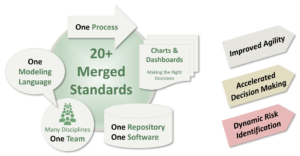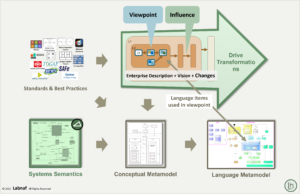What methods can be employed to merge complementary enterprise transformation standards effectively?
How can we consolidate these standards into a comprehensive transformation framework, encompassing one unified process, one content organization, one modeling language, one metamodel, and one flexible repository structure?
How can we ensure that the resulting comprehensive metamodel remains user-friendly and easy to maintain?
How can we systematically organize information in a universally applicable manner that simplifies the generation of data visualization tools such as charts and dashboards?
The first Labnaf training course on Udemy will equip you with the knowledge and practical skills to achieve unification through a systematic approach. It is spanning over 2 hours and is almost free.

This video is an abstract from the training. It explains how Labnaf uses system semantics to semantically merge standards and best practices.
Using your many practical experiences with as many applicable standards and best practices as possible, you create a first version of a unified process for driving transformations.
In that process, you define an initial sequence of viewpoints, a sequence of diagram types, if you want. These are the viewpoints needed for describing an enterprise the vision for transforming the enterprise and the changes to this enterprise.
Then you built a first version of a conceptual metamodel. And that includes the concepts used in the viewpoints.
How can we make sure this conceptual metamodel makes sense? To make sure it makes sense, you use systems semantics. These are the core semantics of any system, like an enterprise, a city, or even the weather. This is a reference to ensure that a metamodel really makes sense.
And what is also essential was the feedback from experts in different disciplines.
Then, from the conceptual metamodel, you create a language and a language metamodel. Then, you use the language in the viewpoints.
Unquestionably, this is an inherently iterative process.



